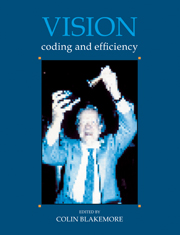Book contents
- Frontmatter
- Contents
- List of Contributors
- Preface
- Reply
- Acknowledgements
- Concepts of coding and efficiency
- Efficiency of the visual pathway
- Colour
- Brightness, adaptation and contrast
- Development of vision
- Depth and texture
- Motion
- From image to object
- 32 A theory about the functional role and synaptic mechanism of visual after-effects
- 33 Spatial and temporal summation in human vision
- 34 The efficiency of pictorial noise suppression in image processing
- 35 Algotecture of visual cortex
- 36 The iconic bottleneck and the tenuous link between early visual processing and perception
- 37 Pyramid algorithms for efficient vision
- 38 High level visual decision efficiencies
- Index
36 - The iconic bottleneck and the tenuous link between early visual processing and perception
Published online by Cambridge University Press: 05 May 2010
- Frontmatter
- Contents
- List of Contributors
- Preface
- Reply
- Acknowledgements
- Concepts of coding and efficiency
- Efficiency of the visual pathway
- Colour
- Brightness, adaptation and contrast
- Development of vision
- Depth and texture
- Motion
- From image to object
- 32 A theory about the functional role and synaptic mechanism of visual after-effects
- 33 Spatial and temporal summation in human vision
- 34 The efficiency of pictorial noise suppression in image processing
- 35 Algotecture of visual cortex
- 36 The iconic bottleneck and the tenuous link between early visual processing and perception
- 37 Pyramid algorithms for efficient vision
- 38 High level visual decision efficiencies
- Index
Summary
Introduction
Late 19th century studies of the brain provided evidence that part of the cerebral cortex was made up of primary sensory receiving areas and primary motor areas. These comprised a relatively small portion of the total surface area of the cortex and with the exception of some specialized regions (such as Broca's area), the functional relevance of the other parts of the cortex remained a mystery. Vision was relegated to a small portion of the human cortex, occupying about 15 per cent of the total surface. Surrounding this primary area were secondary and tertiary zones, often referred to as ‘association cortex’.
Very recent advances in neuroanatomy and neurophysiology, however, have changed this picture dramatically. Thanks to the pioneering work of Allman & Kaas (1974), Zeki (1978), and Van Essen (1985), we now know that monkey visual cortex contains at least 19 separate maps of the visual field and according to a recent review by Maunsell & Newsome (1987) visual processing occupies about 60 per cent of the cortical surface!
This overwhelming dominance of vision in relation to other functions should serve as a reminder that, as generally practiced, the current subdisciplines of visual perception and psychophysics may be too narrow to capture the wealth of processing involved. Threshold psychophysics, especially, has been preoccupied with just the earliest aspects of vision. It has neglected the seemingly intractable questions such as the nature of visual experience, pattern recognition, visual memory, attention, etc.
Meanwhile the neurophysiologists have been making recordings from diverse regions of the visual cortex which could be closely related to these higher functions.
- Type
- Chapter
- Information
- VisionCoding and Efficiency, pp. 411 - 422Publisher: Cambridge University PressPrint publication year: 1991
- 8
- Cited by



